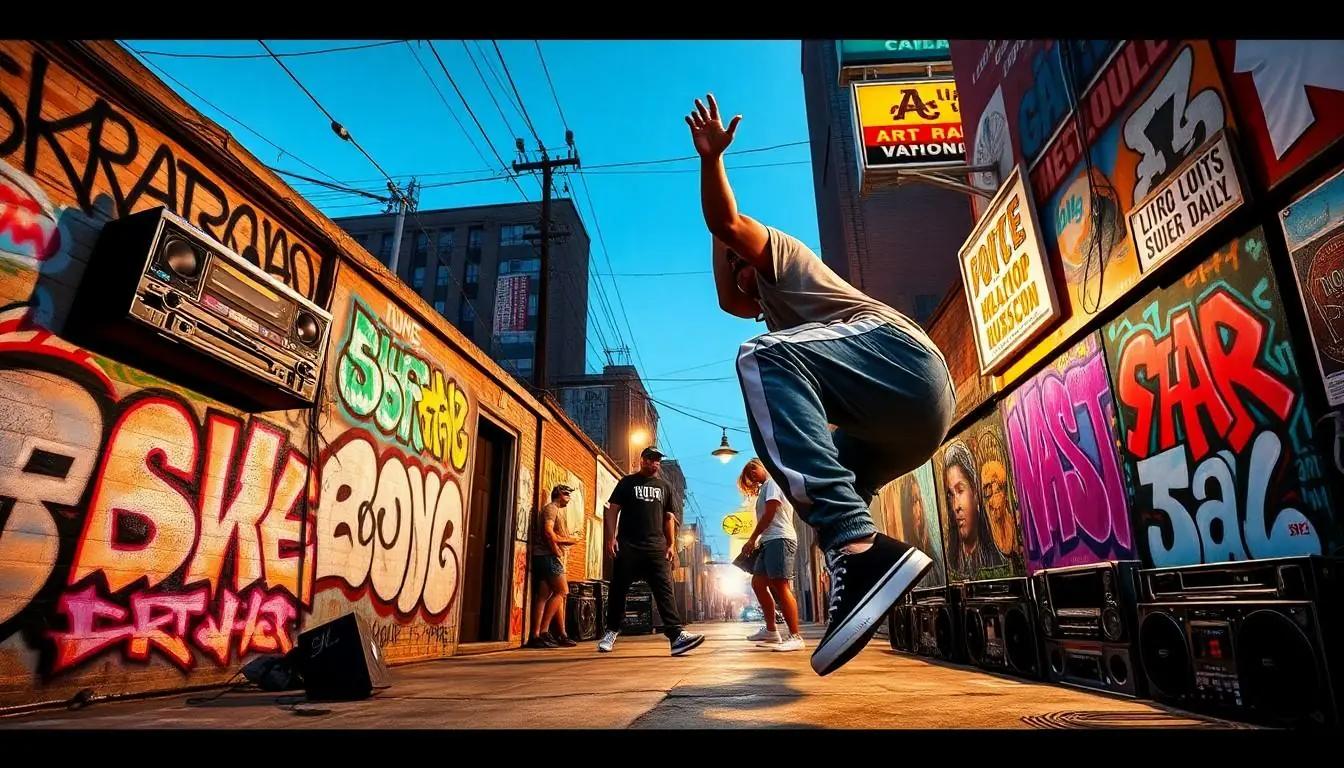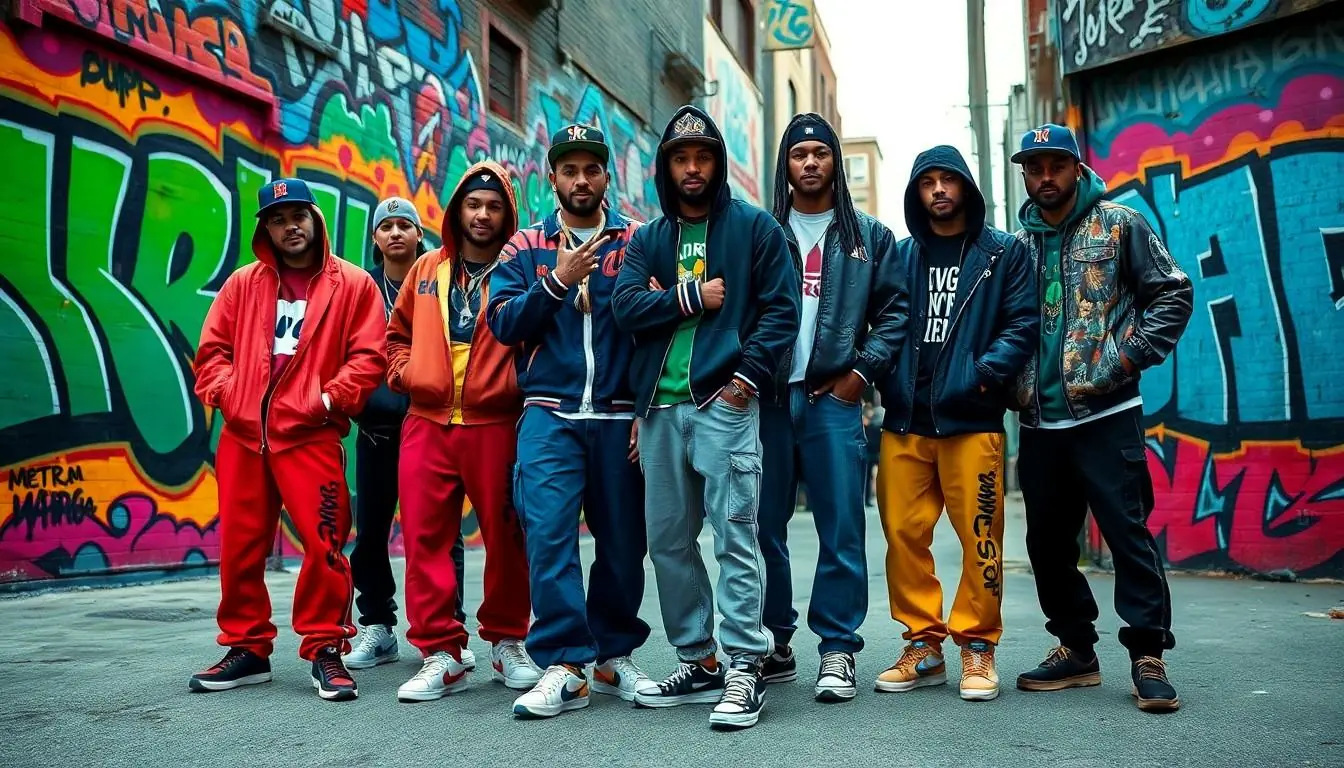The ’90s was a golden era for hip hop, bursting with creativity, innovation, and some seriously unforgettable artists. If you think today’s beats are fire, wait until you dive into the lyrical genius and groundbreaking styles that defined a generation. From the streets of New York to the West Coast, these artists didn’t just make music; they crafted cultural movements that still resonate today.
Imagine a world where your favorite tracks are laced with raw storytelling and social commentary, all wrapped up in infectious rhythms. Whether it’s the smooth flows of A Tribe Called Quest or the hard-hitting verses of Tupac, the ’90s gave us legends that shaped hip hop into what it is now. So grab your boombox and get ready to explore the artists who made the ’90s an unforgettable chapter in music history.
Table of Contents
ToggleOverview Of Hip Hop Artists In The 90s
The ’90s marked a pivotal era for hip hop, showcasing a diverse array of artists who shaped the genre significantly. Iconic figures emerged during this decade, including Tupac Shakur and The Notorious B.I.G., both of whom left indelible marks through their powerful storytelling and social commentary.
Groups like A Tribe Called Quest and Wu-Tang Clan introduced innovative sounds that blended jazz, funk, and street narratives. The lyrical depth of these artists provoked thought, inspiring audiences globally to engage with subjects ranging from systemic injustice to personal struggles.
Many artists used their platform to address pressing social issues. For instance, Public Enemy’s politically charged lyrics rallied listeners to activism. Similarly, Salt-N-Pepa broke boundaries by focusing on female empowerment and sexuality, helping to redefine women’s roles in hip hop.
Record labels played crucial roles in the rise of these artists. Labels such as Def Jam and Bad Boy Records propelled their talent into the mainstream, creating lasting legacies.
Regional sounds characterized much of the decade, with West Coast artists like Dr. Dre and Snoop Dogg popularizing G-funk, while East Coast emcees dominated with intricate rhymes and beats. The South also began to emerge as a significant hub for hip hop with artists like OutKast gaining traction.
By infusing the genre with varied influences and themes, artists in the ’90s not only crafted memorable music but also fostered cultural movements that resonate today. Their contributions remain a cornerstone of hip hop history, influencing countless future generations of musicians and fans alike.
Influential Hip Hop Artists

The ’90s showcased a group of artists who greatly influenced hip hop. These musicians not only created timeless tracks but also pushed cultural boundaries.
Tupac Shakur
Tupac Shakur, known as one of hip hop’s greatest poets, blended personal struggles with political commentary in his music. His albums like “All Eyez on Me” and tracks such as “Changes” awakened discussions about social justice, poverty, and racial inequality. With a dynamic presence, he connected with fans emotionally and lyrically, leaving an indelible mark on the genre. His ability to convey complex narratives made him a voice for marginalized communities, ensuring his legacy endures.
The Notorious B.I.G.
The Notorious B.I.G., or Biggie Smalls, represented the East Coast’s rise during the ’90s. His debut album “Ready to Die” introduced fans to his raw storytelling and unique flow. Tracks like “Juicy” and “Big Poppa” showcased his charm while tackling themes of struggle and triumph. Emcees often cite his intricate rhyme schemes as influential, helping to shape the narrative style in hip hop. Biggie’s untimely death only amplified his impact, solidifying him as a cultural icon.
Nas
Nas emerged as a powerful lyricist, reshaping storytelling in hip hop through his debut album “Illmatic.” Critics often regard this album as a masterpiece, featuring intricate lyrics and vivid imagery that captured life in urban America. Songs like “N.Y. State of Mind” highlight his commitment to honesty and authenticity in his narratives. His influence extends beyond music, prompting discussions about social themes, identity, and the struggles of inner-city life. Nas continues to inspire new generations, showcasing the enduring power of his words.
Iconic Hip Hop Groups
The ’90s witnessed the emergence of several iconic hip hop groups that significantly influenced the genre’s evolution. These groups not only produced memorable tracks but also shaped cultural narratives.
Wu-Tang Clan
Wu-Tang Clan redefined hip hop with their unique blend of gritty street narratives and martial arts influences. Formed in Staten Island, New York, the group included notable members like RZA, GZA, and Method Man. Their debut album, “Enter the Wu-Tang (36 Chambers),” released in 1993, introduced a raw sound characterized by innovative beats and intricate lyricism. This album became a blueprint for many artists in the genre. Beyond music, they created a multimedia brand encompassing films, comics, and clothing. Their influence extended beyond the ’90s, as they continue to impact new generations of artists and fans.
A Tribe Called Quest
A Tribe Called Quest brought a fresh sound to hip hop with their fusion of jazz, funk, and thoughtful lyrics. Formed in 1985 in Queens, New York, the group included Q-Tip, Phife Dawg, and Ali Shaheed Muhammad. Their 1991 album, “The Low End Theory,” is acclaimed for its innovative production and introspective themes. Songs like “Can I Kick It?” showcased their signature laid-back style and engaging storytelling. The group played a significant role in promoting positivity and diversity in hip hop. Their influence persists, inspiring countless artists and contributing significantly to the genre’s evolution.
Evolution Of Hip Hop Sound
The ’90s marked a pivotal evolution in hip hop sound. Artists experimented with diverse musical influences, resulting in unique subgenres. G-funk emerged from the West Coast, blending funk and laid-back rhythms. This style, popularized by Dr. Dre and Snoop Dogg, became synonymous with the era. Meanwhile, East Coast artists like Nas and The Notorious B.I.G. favored complex lyricism and gritty storytelling.
Innovative groups also played a crucial role in transforming hip hop. Wu-Tang Clan combined martial arts themes with street narratives in “Enter the Wu-Tang (36 Chambers).” Their distinct sound and style set a new standard for hip hop. A Tribe Called Quest introduced jazz elements into their music, significantly influencing the genre’s direction. Their album “The Low End Theory” showcased this blend and encouraged positive messaging.
Lyricism experienced a noteworthy shift during this decade as well. Tupac Shakur’s reflective verses focused on personal struggles and broader societal issues. His ability to articulate pain resonated deeply with listeners. Similarly, Public Enemy addressed systemic injustices through powerful anthems like “Fight the Power,” pushing hip hop into a platform for social change.
Regional styles began to assert themselves during this transformation. Southern artists gained traction, with OutKast leading the charge. They infused their work with unique sounds, further diversifying the genre. By the end of the decade, hip hop had evolved into a multifaceted art form, deeply rooted in cultural movements and showcasing a wide range of expressions.
Cultural Impact Of 90s Hip Hop
90s hip hop wielded significant cultural influence, shaping attitudes and societal narratives. The genre provided a platform for artists to address critical issues like systemic injustice, violence, and poverty. Tupac Shakur, through poignant lyrics, captured personal and political struggles, creating powerful narratives that resonated with audiences. Similarly, The Notorious B.I.G. utilized gritty storytelling, reflecting on urban life experiences while defining the East Coast sound.
Innovative tracks from groups like A Tribe Called Quest and Wu-Tang Clan merged various musical styles, contributing to hip hop’s evolving landscape. These artists seamlessly blended jazz and funk with street narratives, pushing boundaries and encouraging thoughtful discourse in their music. During this era, record labels such as Def Jam and Bad Boy Records propelled artists to prominence, highlighting the genre’s growing acceptance in mainstream culture.
Regional diversity emerged as a hallmark of 90s hip hop. West Coast sounds, characterized by G-funk, gained popularity, thanks to artists like Dr. Dre and Snoop Dogg. In contrast, East Coast emcees, with their intricate lyricism, raised the bar for storytelling. Nas’s album “Illmatic” exemplified this shift, offering profound social commentary that educated and engaged listeners.
Southern artists like OutKast played pivotal roles in diversifying the genre, introducing new perspectives and sounds. As the decade progressed, hip hop transformed into a multifaceted form of artistic expression, deeply embedded in cultural movements. This transformation solidified the lasting impact of 90s hip hop, influencing subsequent generations and ensuring its relevance in today’s music landscape.
The ’90s were a pivotal decade for hip hop that laid the groundwork for future generations. Artists from this era not only shaped the sound of the genre but also sparked conversations around social issues that remain relevant today. Their innovative approaches to storytelling and musical experimentation pushed boundaries and redefined what hip hop could be.
As the genre continues to evolve, the influence of ’90s artists is still felt in contemporary music. The cultural movements they inspired have left an indelible mark, ensuring that the legacy of this transformative decade will endure for years to come. Hip hop’s journey from the ’90s serves as a testament to its power as a voice for change and artistic expression.



